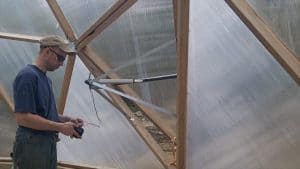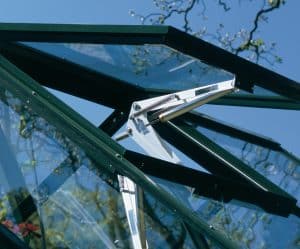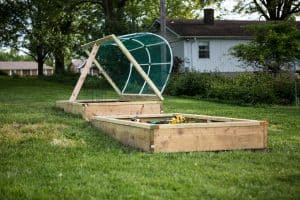Savvy greenhouse owners know maintenance prevents expensive repairs. But there’s one piece of greenhouse equipment that is so easy to repair and troubleshoot that you’ll be wishing all your accessories ran on the heat of the sun.

Solar auto vent openers! Since there is no electricity involved, greenhouse auto vent maintenance and repair is a great starting place for mechanically-challenged gardeners.
Looking for some more background info on greenhouse vents? Take a look at our other helpful guides:
How Do Greenhouse Auto Vents Work?
In order to fix or improve something, it’s helpful to first understand how it operates! Before we get into the nitty-gritty of greenhouse auto vents though, let’s first talk greenhouses. If you’re new to the greenhouse game then you’re going to want to acquaint yourself with some gardening jargon before moving forward.
We don’t want to put the cart in front of the horse. Done with your reading? Good – let’s greenhouse auto vent repairs and maintenance then, shall we?
Hydraulic Operation
Auto vents are hydraulic mechanisms, meaning they use liquid in a confined space to operate.
Automatic greenhouse vents use some type of wax (or other type of substance), whether paraffin (most common) or proprietary blends of mineral wax. The cylinder is filled with this wax, which is the mechanism that opens the vent.
As the weather and air warms, the wax within the cylinder expands, pushing the piston, which pushes the vent arm to the “open” position, and therefore lifting the window.
The hotter it gets, the wider the piston opens the vent. In cooler weather, the vent just opens a bit, or doesn’t open at all, since the wax stays cold and compact.
This is why greenhouse auto-opening vents are also called solar vents. They don’t use electricity, so don’t be confused about the “solar” terminology! There is no solar-voltaic energy involved. Does this term bring back bad memories of elementary school vocabulary quizzes? Don’t fret, give our greenhouse solar guide a read to learn all about voltaic energy.
Different vents are outfitted with different types of wax that are sensitive to varying temperatures—that’s what makes it possible for you to buy auto vent openers that open at different temperatures.
Parts of the Auto Vent

Cylinder
The cylinder filled with wax typically screws onto
Piston
Just like a piston in an engine, the piston of an auto vent opener is contained within the cylinder. A seal between the piston and the cylinder keeps the wax in place inside the cylinder and allows the piston to slide in and out of the cylinder smoothly.
Little mechanical lesson: pistons and cylinders always go together!
And pistons also often pair well with…springs!
Spring & Arm
The “arm” of your auto vent opener is actually two pieces that could both be called arms. One attached the whole mechanism to a base (probably your greenhouse frame or another window) and “pusher” arm does the window opening action.
When the arm is pushed by the piston, it in turn pushes the window open. Easy enough. But it needs support to close!
The mechanical arms are almost always connected to one another with a strong spring or two—sometimes three! The more springs or the stronger the springs, the more
Greenhouse Auto Vent Maintenance and Repair

Cleaning
The only maintenance you need to take care of on your vent is a good wipe-down and general cleaning. Wipe down all parts including the piston rod—removing the cylinder from the vent arm—every so often
Lubricating
Your auto vent opener’s moving parts are working hard! Be sure to apply a small amount of oil to the moving parts, including the piston where it inserts into the cylinder, from time to time. Anything from WD-40 to coconut oil works fine.
Troubleshooting Your Greenhouse Auto Vent

Vent Not Opening
If your auto vent stops opening, it could mean a couple things:
Either:
- Seal has broken or become worn, and wax has leaked out.
Over time, the movement of the piston will wear down the seal, causing wax to leak out of the cylinder. It’s pretty much inevitable, even with the best and most well-kept openers, if
Loss of wax diminishes the pressure inside the cylinder, which means the piston won’t push the vent open all the way. As more wax is lost, the vent will continue to decrease in range of motion. If a lot of the wax leaks out, the piston won’t open the window at all.
Unfortunately, there’s no good way to fix this problem.
The good news is that you can buy a replacement cylinder for relatively inexpensively. The installation is quite easy (see below).
Or:
- Wax has congealed.
BUT it could also be that the wax in the cylinder needs a reset. Here’s how.
Resetting The Piston
Remove the cylinder and piston from the housing. Usually that simply requires a quick unscrewing. Some vent openers have a pin that keeps the piston attached to the housing.
If there is any additional hardware that attaches the cylinder to the arm housing, be sure to put it in a safe place.
Place the whole cylinder in the refrigerator for a couple hours.
Remove the cylinder from the refrigerator and use a hard surface (like your driveway or a brick wall—not your nice hardwood floor or granite countertops!—to press the piston back into the cylinder. This will take some oomph! Be careful as the cylinder may be slippery from condensation in the refrigerator. It’s best to use gardening gloves or a rag to help your grip.
Be sure to refer to any instructions that came with your auto vent opener to see how far the piston should be protruding from the cylinder.
Replace the cylinder-piston unit and you should be good to go!
Vent Opening Just a Little
See above: regarding a broken or worn-down seal. If the piston is pushing the vent at all, the wax is likely still functioning. But if the range of motion of the vent has been reducing, it’s likely that wax is leaking. You’ll need to replace the cylinder!
Vent Not Closing
Your wax may have congealed (see above for the fix), but it’s also possible that a spring is broken or weakened somehow. Check out the springs that connect the arms of the opener to see if they are broken, rusted, or stuck.
Cylinder Replacement
Replacing the cylinder and piston of a greenhouse auto vent opener is quite simple. Most cylinders screw easily into some hardware or housing on the vent arm.




